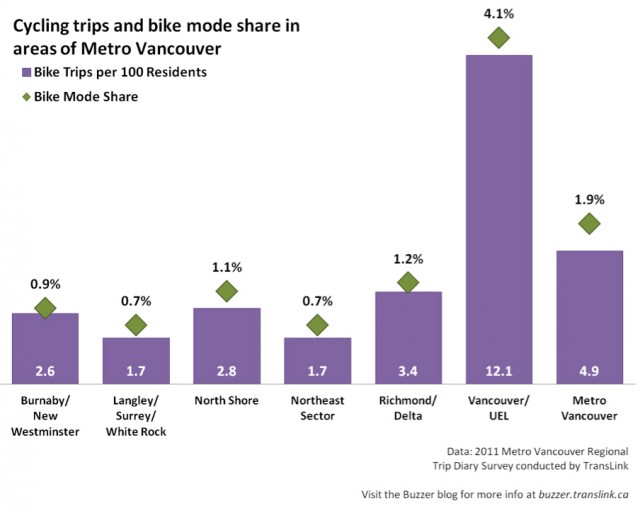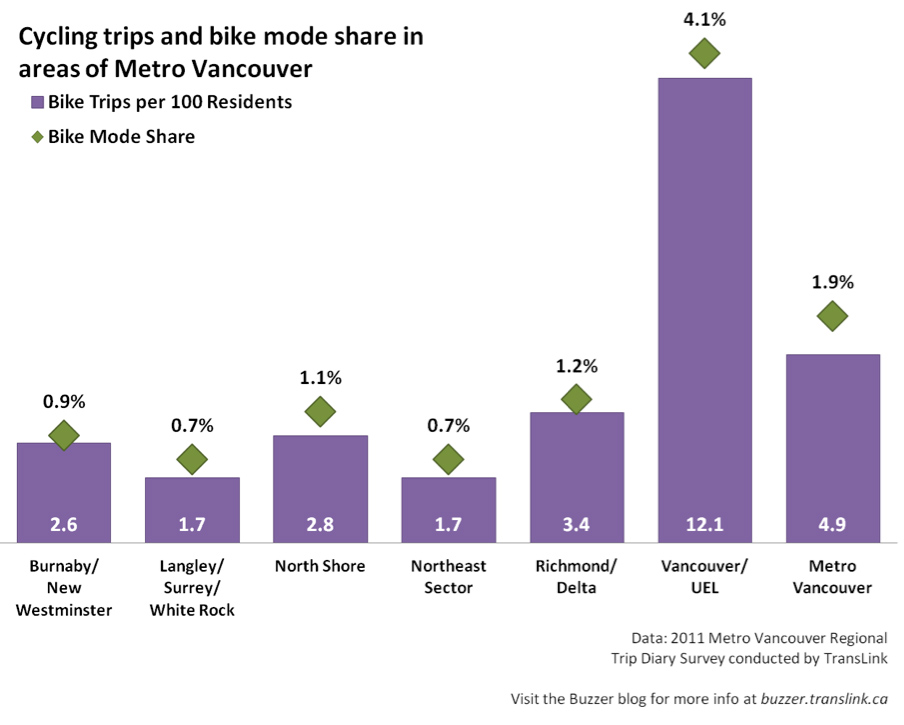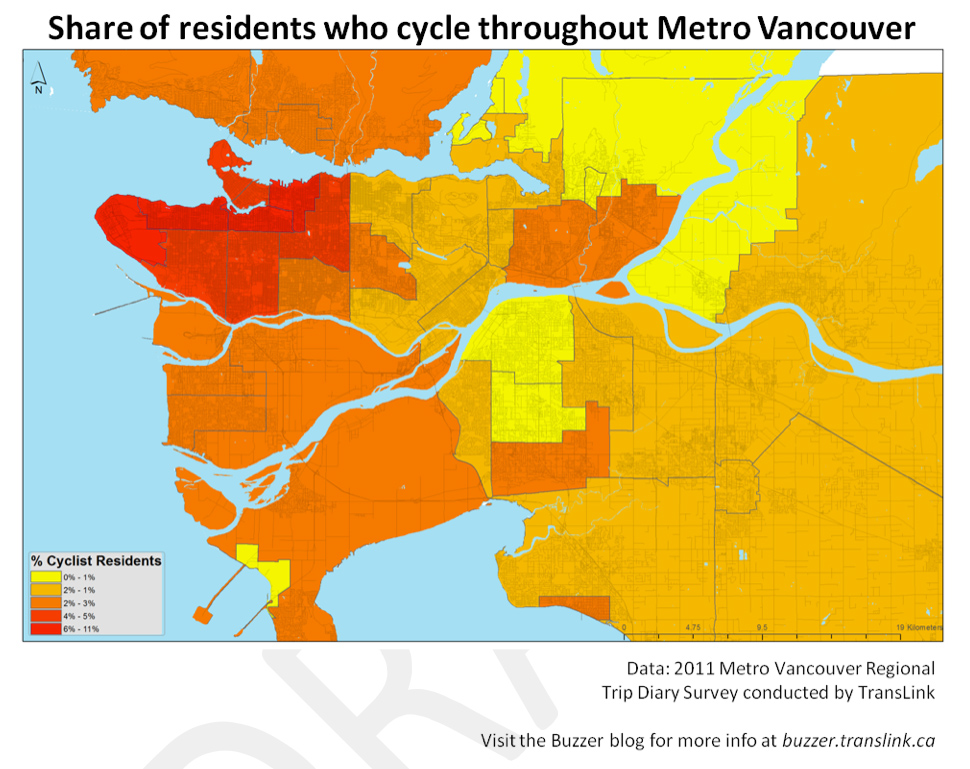Cycling is at its highest levels yet in Metro Vancouver: more insight from our trip diary survey
Cycling is at its highest levels yet in Metro Vancouver: more insight from our trip diary survey

As Bike to Work Week kicks off this week, we’ve got a plethora of cycling stats for you from the 2011 TransLink trip diary survey.
(As you might remember from last week’s post about popular modes of travel in the region: we do a trip diary survey with over 22,000 households in our region every three to four years, building “snapshot” of a day of Metro Vancouver transportation. We’ve been analyzing the results of the 2011 trip diary now, and we wanted to share what we’re learning about the region with you over the coming weeks and months!)
It turns out cycling is at its highest levels yet in Metro Vancouver, making up 1.8 per cent of trips in the region. That’s 106,500 trips per day, with 55% to and from work!
Again, our press release has the highlights:
The number of bike trips has grown faster than the Metro Vancouver population
- The total number of bike-only trips increased 26 per cent between 2008 and 2011, from 84,300 to 106,500; while the regional population increased 5.8 per cent from 2,186,200 to 2,313,000. Notably, the number of bike trips in the City of Vancouver increased by 35%
- 55% of bike trips were to and from work
Bikes are integrating into the transportation network
As well as the 106,500 daily bike trips, another 6,200 bike trips were combined with other transportation modes:
- 65% connecting with transit
- 18% connected with a car as the driver
- 13% connected with a car as the passenger
Cyclists are making use of TransLink’s integration of cycling into the overall system:
- All buses are equipped with bike racks
- Bikes may be brought onto SkyTrain or West Coast Express (with restrictions as to the number of bikes per car and time of day)
- Lockers available at most SkyTrain stations and many park-and-ride facilities
Who cycles?
- 75% of people who bike are between the ages of 25 & 64; that age group makes up 62% of the general population
- Men are still more likely than women to ride: 71% of cyclists are men
- Experience with other cities shows women are more likely to ride bikes where there are networks of traffic-protected bikeways.
Region-wide, there were 4.9 bike trips per 100 residents per day.
- Vancouver (combined with University Endowment Lands) had the highest rate of bike use: 12.1 trips per 100 residents, with the heaviest concentration of bike use along the Broadway Corridor
- Richmond/Delta: 3.4 trips per hundred
- North Shore: 2.8
- Burnaby/New Westminster: 2.6
- Langley/Surrey/White Rock: 1.7
- Northeast Sector: 1.7
It’s great to see an upward trend, but there is definitely still lots of potential! The region’s long-term vision, as outlined in the Regional Cycling Strategy, is a 10% cycling mode share by 2040—the trip diary notes that 22% of motorized trips were shorter than 5 km, and many of these trips could be converted to bicycle trips. And TransLink market research from 2010 indicates that nearly 50% of people in the region cycle sometimes, with 25% of people cycling at least once week in at least one season and another 22% cycling at least once a year.
The full briefing paper and graphs for sharing
As always, for all the details, download this in-depth briefing paper, which shares the analysis we’ve done regarding regional mode share based on the trip diary results. You can also see (and share!) these spiffy graphs developed from the info below. (Click to enlarge each one!)
It’s again very useful to know how our region’s doing, especially as we’ll be discussing our 30-year long-range transportation plan in the coming year or so. Feel free to ask us any questions!








As I suspected, cycling trips in the city of Vancouver are way up. If we are to encourage this mode of transportation, it will be most cost effective to do so here. The outer municipalities are not set up for cycling to really get popular as it was. Density is low and more people own vehicles. You can put down bicycle lanes all you want out here, but good luck getting people to use them. Until regional density increases further to the point it ‘feels’ more like False Creek, you’re just not going to see those same gains out here.
I’m very surprised to see that Burnaby’s increase is actually quite low, especially in comparison to Richmond’s. I suspect that the terrain features quite heavily into this. It’s much easier to cycle in Richmond than it is Burnaby. The terrain is such that even cycling long distances, like from Queensboro to Richmond Centre is feasible because of long flat expanse and bike trail between the two areas. The grid system along with bicycle lanes in western Richmond also seem to help a lot. If I’m right about the terrain being a problem, I imagine it will be very difficult to get cycling popular in cities like New Westminster or Coquitlam.
I think the lack of bike infrastructure in Burnaby has a lot to do with it. There’s the BC Parkway along the Expo Line and the (incomplete) Central Valley Greenway somewhat along the Millennium Line – and other than that? Lines and bicycle images painted onto streets don’t make a bike route. A lot of drivers already don’t see bikes and we expect them to see the image of a bike painted on the road???
When I’ve taken the Canada Line out to Richmond I’ve seen the bike route on the street there and wished more routes were set up like that. The sidewalk, bike route and street are each at their own level, meaning you can’t ‘accidentally’ end up in the wrong lane.
Along with density and relatively flat land, safe places to ride are needed to encourage people to cycle. Whenever I’ve had to ride next to car traffic, I’ve felt like an invisible moving target. That’s hardly a slogan to encourage more people to try cycling.
When I see discussions of transit and cycling I always like to point out that the bike racks on the buses have a much greater role in promoting cycling than you can judge simply by counting the number of bikes that actually use them. People such as myself often choose to cycle based on the availability of rack-equipped buses as a fallback if the weather should turn too nasty or if the trip gets to be too exhausting. I know I’ve done this on numerous occasions, even though I’ve only had to resort to using the racks once in the past several years.
I don’t know of any way you could capture the number of bike trips “inspired” by bus rack availability, but I’m sure it’s not trivial.
I do like the way Richmond’s bicycle infrastructure is set up. Properly used, right hooks are eliminated as motorists must make a lane change into the bicycle lane before turning right. I don’t know how many people actually do that, but that’s the intent, anyway.
Where I am normally afraid of being hit by a cyclist while driving, in Richmond, due to the way the infrastructure is setup, I am much more comfortable sharing the road with them. And in Richmond this is a must; it doesn’t have the ‘quiet’ alternate routes Vancouver does like Heather or Ontario streets.
Sharrows are useless. Either build a second lane or provide an alternate route for cyclists. I see sharrows and all I can think of is how I’m going to be passed on the right at the last moment when making a right turn or legally passing a vehicle in front that is turning left. This means I tend to do the opposite of what they intend, by hogging the curb to ensure that I am not passed unsafely.
Separating vehicles and bicycles completely is the only way to ensure the safety of both groups. Politically, it’s the only way to get cycling accepted as a legitimate means of transportation. After all, when people see a ‘road warrior’ zipping in and out of traffic and cutting off people, they’re likely to think, “wow, what a psycho! I’m not taking up cycling; it’s dangerous!” But see a cyclist zipping down a dedicated bicycle path and that same person is likely to think, “Hmm, that’s not too shabby. That bike trail is actually pretty close to ‘insert road person used to commute’. I might just start using my bicycle on sunny days instead!
We’re coming at this from opposite sides and yet we come to some of the same conclusions Cliff. “Sharrows are useless. Either build a second lane or provide an alternate route for cyclists” and “Separating vehicles and bicycles completely is the only way to ensure the safety of both groups.” I so totally agree!
Somewhat related: Netherlands highways will glow in the dark starting in mid-2013
http://arstechnica.com/business/2012/10/netherlands-highways-will-glow-in-the-dark-starting-in-mid-2013/
[…] is years ahead of its ridership projections, averaging 110,000 passengers a day. Cycling is the fastest growing mode of transportation in Vancouver, and 4.1% of all trips are now done on a bike (1.9% in Greater […]
[…] More here. […]
Richmond has great potential for both bike routes on arterials as well as routes like Vancouver has in quiet residential areas. If the cul-de-sacs connected with bike and walking pathways routes could be made. Also more bridges over drainage canals.
All it takes is a plan and the city to decide to do it.
Sharrows aren’t as nice as other things but they are a start and they can help indicate where to stay out of the door zone so they’re better than nothing.
Thanks for your share.
I’m very surprised to see that Burnaby’s increase is actually quite low, especially in comparison to Richmond’s.